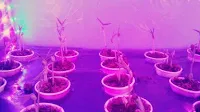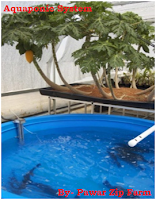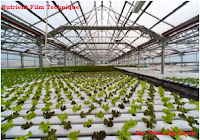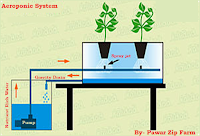Hydroponic cultivating can be VERY muddled, with PCs and sensors controlling everything from watering cycles to supplement quality and the measure of light that the plants get. Then again, hydroponics can likewise be inconceivably straight forward, a hand watered basin of sand with a solitary plant is additionally a technique for hydroponic cultivating. Most leisure activity arranged hydroponics frameworks are somewhere close to the two limits referenced previously. The "normal" home hydroponic framework as a rule comprises of a couple of essential parts: a developing plate, a repository, a straightforward clock controlled submersible siphon to water the plants and a pneumatic machine and air stone to oxygenate the supplement arrangement. Obviously, light (either characteristic or counterfeit) is likewise required.
History of Hydroponics.
Hydroponics fundamentally implies working water ("hydro" signifies "water" and "ponos" signifies "work"). Various civic establishments have used hydroponic developing methods since forever. As noted in agriculture Food Production. Egyptian hieroglyphic records going back a few hundred years B.C. depict the developing of plants in water." Hydroponics is not really another strategy for developing plants. In any case, mammoth steps have been made throughout the years in this creative region of horticulture. All through the only remaining century, researchers and horticulturists tried different things with various strategies for hydroponics. One of the potential uses of hydroponics that drove research was for developing crisp produce in nonarable regions of the world. Some individuals can't develop in the soil in their general vicinity (if there is even any soil whatsoever). This utilization of hydroponics was tried amid World War II.
Troops positioned on nonarable islands in the Pacific were provided with crisp produce become in privately settled hydroponic frameworks. Later in the century, hydroponics was coordinated into the space program. As NASA thought about the items of common sense of finding a general public on another plant or the Earth's moon, hydroponics effectively fit into their supportability designs. This examination is progressing. In any case, by the 1970s, it wasn't simply researchers and examiners who were engaged with hydroponics. Customary ranchers and excited specialists started to be pulled in to the temperances of hydroponic developing. A couple of the positive parts of hydroponics include: The capacity to deliver higher yields than conventional, soil-based horticulture Allowing nourishment to be developed and expended in regions of the world that can't bolster crops in the dirt Eliminating the requirement for huge pesticide use (considering most bugs live in the dirt), successfully making our air, water, soil, and sustenance cleaner Commercial cultivators are running to hydroponics more than ever. The beliefs encompassing these developing strategies address subjects that the vast majority care about, for example, helping end world appetite and making the world more clean. Notwithstanding the broad research that is going on, ordinary individuals from everywhere throughout the world have been building (or buying) their very own frameworks to develop incredible tasting, new nourishment for their family and companions.
Teachers are understanding the astounding applications that hydroponics can have in the classroom. Also, aspiring people are endeavoring to make their fantasies materialize by making their living in their lawn nursery, pitching their produce to nearby markets and eateries.
General Hydroponics.
Yields Crops created in the present current nursery ranges are numerous and fluctuated. They can be inexactly sorted as pursues: vegetables including tomatoes, cucumbers, extravagant lettuces, ringer peppers, cherry tomatoes and a large group of minor ones, for example, radish, melon and strawberry. cut blossoms for example roses, mums, carnations, pruned blooms for example geraniums, azalea, poinsettia, tulip. various sheet material plants.
Hydroponics Growing Media
Porous, all around circulated air through substrate are utilized as mooring for the plants root framework and bolstering territory. Rockwool and Heydite are the most well known as they are most promptly accessible, and simplest to utilize and transport. There are different mediums which are not as generally utilized. Developing Techniques There are distinctive approaches to convey water to the plants. Snap for more information Learn increasingly about developing strategies. Nutrient Film Technique, Drip-Irrigation or Micro-Irrigation, Aeroponics, Deep Water Culture, Flood and Drain, Home Hobbyist Systems, Passive Planters.
Hydroculture.
Carbon Dioxide Enrichment In an open air garden the CO2 level noticeable all around is around 300 parts-per-million (ppm). Plants flourish when they can take in a more elevated amount of CO2. Cultivators today screen their nursery CO2 levels with uncommon reason control screens which thusly work CO2 burners or generators to renew CO2 devoured by the plants.
HAF (Horizontal Air Flow)
Working with CO2 enhancement and to be sure an essential piece of the nursery condition is level wind current. Considered in the late seventies after research including better parts of nursery air course, flat wind current, or HAF as it is presently alluded to, is broadly utilized. Security Commercial producers end up with truly sizeable bits of their yearly turnover as work-in-process. The closer the yield gets the opportunity to collect, the higher the danger of cataclysmic misfortune, should a key piece of the nursery's atmosphere control framework come up short. In like manner, cultivators put everything on the line to secure themselves. Early cautioning is an imperative piece of their security. Most presently utilize programmed telephone dialers with electronic voice reenactment to alarm them of approaching issues some time before genuine harvest harm can happen. Biologicals Environmental concerns are highest in the psyches of the present expending open. The plant business has been working for a long time to decrease its reliance on concoction pesticides, a significant number of which have been connected to malignant growths. Quantities of key pesticides have been deregistered for specific yields, others have been expelled from the market by and large. Promising advances have been made in the utilization of predator bugs in nursery extends as normal natural control against vermin bugs. While much work stays to be done to instruct the producer in their utilization, dynamic individuals from the business are presently well on their approach to 100% organic bug control.
Honey bees in hydroponics
Until as of late, fertilization of nursery tomato crops was practiced with a labourious technique for natural product support vibration using battery worked hand-held vibrators ("electric honey bees") physically contacted against develop bloom sets. It was an entirely counterfeit method for mimicking characteristic fertilization without a characteristic open air condition where wind and creepy crawlies are the vectors. In the present current tomato ranges, hives of honey bees are put deliberately among the yield and left to achieve normally what has been, as of recently a dreary and repetitive undertaking for nursery staff.
Lighting in hydroponics
In request to get the most ideal outcomes from a Controlled Environment Agriculture System, we should bring the range and power of daylight inside. This is practiced utilizing High Intensity Discharge lights. These lights, related to extraordinarily structured illuminating presences, will reflect light downwards to plants, where it might be used to the most extreme.
various individual control units.
Bioponics
The organic agriculture show or Bioponics, we believe, is of serious interest to each industrial and hobby growers. This methodology employs Associate in Nursing organic tea primarily based nutrient resolution with additional microorganism agents to facilitate their breakdown into mineral parts that plants are ready to soak up.
Controlled Environment Agriculture Systems industrial Structures
Today's industrial greenhouses ar made of galvanized steel, extruded metallic element, fibreglass, polycarbonate, acrylic, polythene and glass. The percentage of every, comprising a typical structure, varies by sort of style. Loosely categorized, the following basic shapes and styles are prevalent: freestanding grade to grade hoop houses (quonset) clad in polyethylene, double polyethylene, corrugated fibreglass sheet, or plastic composite structured panels joined or gutter-connected straight-wall hoop homes clad in polythene, double polyethylene and so on. As above linked or gutter-connected straight-wall hoop houses clad in curved automotive glass linked or gutter-connected straight-wall peaked homes clad in flat tempered glass. This kind of vary breaks down into 3 any subcategories:- single peak gutter-to-gutter- double peak with floating gutter- triple peak with 2 floating gutters. All of the higher than designs or styles of greenhouses ar widespread, the agriculturist choosing that he can build supported crop to be grownup, usage pattern, seasonal pattern, furthermore as economic concerns. Nutrient control insures that the plants get the minerals they need at the right pH and temperature.
Faster growth then soil grown plants.
No weeds. The medium is mostly inert and unless it is out doors, there is no way for weed seeds to get into the growing medium.
No guess work about what nutrients are going to the plant. Easy to correct for plant deficiencies.
No backbreaking soil conditioning. The water has all the nutrients that's needed by the plants. The roots haven't got to grow larger searching for food. The growth of the plant goes principally to the higher plant. Plants will be spaced nearer along then in soil. Spacing relies solely on the area required to provide adequate lightweight to the plant.
Garden can be at a good working height.
Up to twenty times the number of plants will be big within the same area in agriculture then in soil. No soil to harbor bugs. Healthy plants have better taste. Healthy plants resist insect infestations. Less insecticide is needed. Educational for youngsters of all ages learning concerning plant growth. Faster growth so that more then one crop can be raised in a season. Can be created transportable so you'll move it from room to room or take it with you once you move. Ground is left undisturbed on rented property. Condensed growing ways build higher use of greenhouse area. Consumes 1/10 the water that field crops do. Conversation piece. Good leisure pursuit for people who likes to tinker.
Some disadvantages to growing plants in hydroponics are; Higher cost to get started then soil culture. System failure may end in a lost crop if not caught quickly. Some systems can go days before damage occurs.
Watering ways in hydroponics
All the plants desires area unit provided by water. The roots area unit placed in associate inert growing medium. Water, enriched with all the nutrients the plants would like, is supplied to the roots by several different methods.
1. Aeroponics; the roots area unit sprayed with the nutrient resolution. This technique ensures that the foundations get lots of gas to the root system. It has not been proved that this technique helps to form plants grow any quicker then in alternative ways. It has some inherent issues like nozzles obtaining blocked up. One of the more expensive methods of hydroponics.
2. Ebb and flow; additionally referred to as flood and drain. Periodically floods the medium. As the water drains out new air comes in. Not as arduous to take care of as Associate in Nursing aeroponics system. Roots can plug up waterways however.
3. NFT; the Nutrient Film Technique is one among the ways most frequently employed by business growers. Plant roots ar contained in an exceedingly channel through that a skinny "film" of nutrient resolution passes. The nutrient resolution is aerated and recycled with the addition of makeup water.
4. Run to waste; during this technique the nutrient is fed to the plants at close to a similar rate because the plants use the water. In all the opposite ways, the nutrient solution returns to a tank to be recycled. This system is that the least expensive to urge started, however, it requires a lot of monitoring to insure the plants are getting enough nutrient but at the same time not getting too much nutrient. Plants can solely take up the nutrients it desires. On sunny days they take up principally water and leave the nutrients behind to make up. The engineered up salts should be purged from the system one or two occasions per week. This system wastes the most nutrients. Systems Plants most generally have to be stared in a small amount of medium before they can be placed in the growing area. Seeds ar started with no nutrients within the water. Seeds have their own food and do not need any extra nutrients till the primary set of leaves seem. Nutrient is additional at 0.5 strength to encourage root development till it's transplanted. Then full strength nutrients ar used for the remainder of the plants growth. There are two kinds of formulas for plants. One promotes the vegetative growth and also the different promotes mature. A system that has each kinds of plants can have to be compelled to have one or the opposite formulas betting on that crop is additional necessary.
There are 2 ways of growing systems, horizontal and vertical. The following are systems: Bag culture; used commercially in run to waste systems. The hobbyiest can also use this inexpensive method in a recirculating system. Bags are filled with a lightweight medium and nutrient is fed to each bag by inexpensive spaghetti tubes. Has the advantage of having the ability to area the plants as they mature.
Tomatoes in bag culture.
Gutter/NFT; a great deal of hobbyiests have tried on the subject of everything with this sort system.
1. Manufactured channels; sq. corners facilitate to stop damming.
2. Rain gutter; Metal gutter can oxidize and add undesirable materials to the nutrient solution. Line with plastic sheet. Plastic gutters need total support to stay it strait.
3. PVC pipe; most hobbyiests use PVC pipes with holes drilled for plants. This system is sometimes costlier then bag culture. Too typically the roots obstruct the waterways and dam the water inflicting plant disease. Aeration within the root zone might become a haul. Beds; are extra wide channels. Beds can be filled with a growing medium or pots can be placed in the bed so that they will pick up the water from the bed through a wicking action. Pots are the most versatile. Plants are often spaced to fulfill the plants desires. I use this technique for houseplants and for beginning seeds. A 1/4 in. of water are often maintained in beds with pots. Water must be drained well in filled beds. Beds can be made from any material that will hold the weight of the plants and the medium. A wrapper are often wont to line construction. Nutrient resolution is sometimes aerated and came to the bed.



